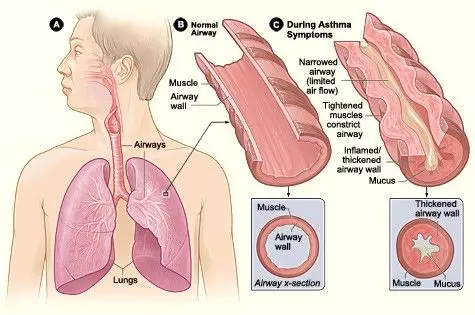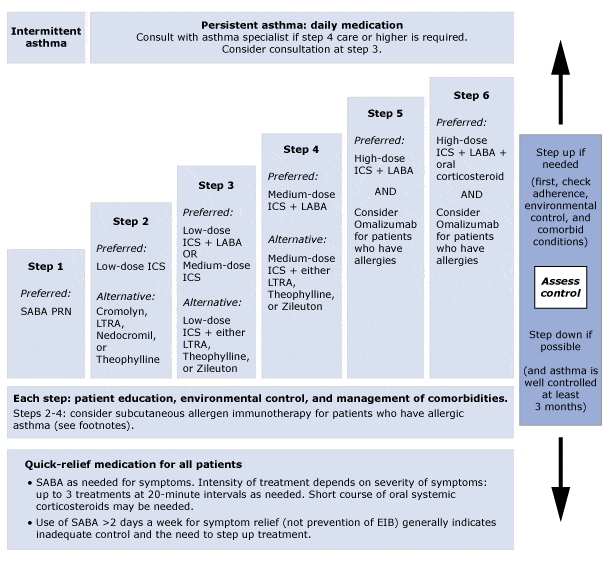Next Lesson - Chronic Obstructive Pulmonary Disease
Abstract
- Asthma is a chronic disorder of the airways characterised by intermittent airway obstruction and airway hyper-reactivity. It is usually reversible, either spontaneously or with treatment.
- Triggers of asthma include allergens, house dust mite faeces, cold air, exercise, fumes, cigarette smoke and certain drugs.
- The immediate inflammatory response is initiated by IgE antibodies, whilst the late phase is initiated by mast cells and eosinophils. The inflammation causes mucosal swelling, thickening of the bronchial walls and an increased production of mucus.
- Asthma diagnosis has a bimodal age distribution: children (most common) and adults in their early 40s.
- Common symptoms include a dry cough (more common at night), expiratory wheeze, breathlessness and chest tightness.
- Diagnosis is usually made through spirometry and peak flow measurements. Peak flow will be reduced compared to a person of the same age/gender with healthy lungs, and spirometry will show a reversible obstructive pattern.
- An exacerbation of asthma can be graded on its severity, ranging from mild to near-fatal. It is important to distinguish between these different types in order to arrange for the most appropriate treatment for the patient.
- Management of chronic asthma is achieved through secondary prevention and medication, which is prescribed in a stepwise fashion and should be continually reviewed, along with ensuring correct inhaler technique. Every patient should have a self-management plan for acute exacerbation.
Core
Guidelines on management pathways and classifications of severity of asthma used in this article can be found here: https://www.brit-thoracic.org.uk/quality-improvement/guidelines/asthma/
Asthma is a chronic disorder of the airways, characterised by intermittent airway obstruction and airway hyper-reactivity. It is usually reversible, either spontaneously, or with treatment.
A typical asthmatic will have an ‘asthma attack’ after exposure to a trigger that causes the patient to have a hypersensitivity reaction. The chronic inflammatory process seen in asthma is primarily driven by TH2 cells. In this process, macrophages process and present the trigger to T lymphocytes, which active the TH2 cells. These cells then release cytokines which attract and activate inflammatory cells, including mast cells, eosinophils and B cells (which produce IgE antibodies).
The reaction usually results in a two-phase response, consisting of an immediate response, which reaches its peak in around 20 minutes, and a late phase response, between 3-12 hours later.
In the immediate response, the IgE antibodies then cause mast cell degranulation, and the release of mediators such as histamine, tryptase, prostaglandin D2 and leukotrienes. It is these mediators that then cause the bronchial smooth muscle contraction of the airways, which leads to the bronchoconstriction seen in an asthma attack. This is an example of type I hypersensitivity.
In the late phase response, the mast cells and eosinophils release mediators and cytokines, which cause airway inflammation. A specific example of this is leukotriene C4 released by the eosinophils, which is toxic to the epithelial cells of the airways, causing them to shed. This is an example of type IV hypersensitivity.
The airway inflammation causes mucosal swelling due to the endothelial leakage caused by the immune response, which reduces the calibre of the airway. The infiltration of inflammatory cells causes thickening of the bronchial walls. There is an increased production of mucus, which is thick and slow moving, and contains the epithelium shed by the airways.
If the asthma is poorly controlled, there can be permanent remodelling of the airways, which may not be fully reversible. These changes include hypertrophy and hyperplasia of smooth muscle, hypertrophy of mucus glands, and thickening of the basement membrane.

Diagram - Normal airway vs asthmatic airway
Public Domain Source by United States-National Institute of Health: National Heart, Lung, Blood Institute [Public domain]
There are a wide range of things that can trigger asthma, including allergens, house dust mite faeces, cold air, exercise, fumes, cigarette smoke, perfumes and certain drugs, for example NSAIDs and β-blockers. Examples of allergens include pollen and animal hair/dander.
The inflammatory changes seen in asthma cause the airways to become hyper-responsive, meaning an asthma attack can be triggered in response to non-allergic stimuli.
Asthma is most commonly diagnosed in those under 18, but there is also another peak of diagnosis in the early 40s.
Common symptoms of an asthma attack are:
- Dry cough – that is more common at night due to increased vagal activity.
- Expiratory wheeze – heard either audibly or through a stethoscope.
- Breathlessness
- Chest tightness
Asthma as a first presentation can present with a history of asthma attacks, or mild presentations of the symptoms above in a chronic nature.
The patient may also have a history of atopy (inflammatory processes seen elsewhere in the body) such as hayfever or eczema.
On examination, the patient may have an increased respiratory rate, increased heart rate, and decreased O2 saturations. If the patient is having an acute asthma attack, there may also be an expiratory wheeze on auscultation.
Asthma is usually diagnosed via spirometry and peak flow. Peak expiratory flow (PEF) can be measured using a peak flow meter in a GP setting, but can also be measured daily by a patient at home.
To use a peak flow meter correctly, there should be a ‘best of three’ approach, where the patient takes three peak flow readings, and records the highest. The peak flow reading for the patient can then be compared to what is expected of someone who is their age and gender: if this is reduced then it can be suggestive of asthma, although the diagnosis is usually confirmed with other investigations, such as spirometry.
If a known asthmatic patient records their peak flow readings regularly (for example three times per day), this can be a useful indicator of how well controlled their condition is. When spirometry is performed on an asthmatic patient it will show an obstructive pattern, where the FEV1/FVC ratio is <70%, but this pattern is reversible with a short-acting β-agonist. It is important to note that this can be compared to COPD in which there is no reversibility on administration of a β-agonist.
Management of chronic asthma is achieved through secondary prevention, by removing triggers from the home if possible, and through medication.
The use of medication for asthma follows the stepwise management pathway, in which the patient’s medication is reviewed regularly, and then may be stepped up or down depending on symptoms. This is performed with the aim that the patient is on the least amount of treatment needed to effectively manage their symptoms and prevent an acute exacerbation.
The stepwise plan is outlined below. Before escalation, it is important to check compliance with the current regimen, as improving inhaler technique or compliance may be more effective than changing the medication.
- Step 1 – the patient should be prescribed a short-acting β2 agonist (SABA) such as salbutamol or terbutaline. These act through preventing and reversing bronchoconstriction, and should only be used on an as-required basis.
- Step 2 – introduction of a regular preventative inhaler, by prescribing an inhaled corticosteroid (ICS) such as beclomethasone to reduce inflammation in the airways..
- Step 3 – introduction of a long-acting β2 agonist (LABA) such as salmeterol or formoterol, which is considered if the patient’s symptoms aren’t controlled with the maximum dose of an ICS. LABAs are not anti-inflammatory on their own so must always be prescribed with an ICS, commonly in one inhaler.
- Step 4 – alternative add-ons are considered, including higher-dose inhaled corticosteroids, leukotriene receptor antagonists, theophylline and tiotropum.
- Step 5 – referal to specialist care. Can involve introduction of oral steroids and/or biological therapies.
Signs that a patient needs to be moved to the next step in the escalation pathway include using their SABA >3 times a week, being woken from sleep by symptoms more than once a week, having symptoms >3 times a week, or have had an exacerbation of asthma requiring oral steroids within the past two years.
Every asthmatic should have a self-management plan that has been devised between them and a healthcare professional, which has written instructions on when and how to step-up and step-down their own treatment. This leads to better outcomes in terms of day-to-day control, frequency and severity of exacerbations.

Diagram - Stepwise management of asthma, as per the most recent guidelines
Creative commons source by National Heart, Blood, and Lung Institute [CC BY-SA 4.0 (https://creativecommons.org/licenses/by-sa/4.0)]
An exacerbation of asthma (an ‘asthma attack’) can be graded on its severity, ranging from mild to near-fatal. It is important to distinguish between these different types in order to arrange for the most appropriate treatment for the patient. The following information can be used to help distinguish the severity of asthma in people over 12, in accordance with the most recent NICE guidelines.
Classifications of Asthma Exacerbations According to the British Thoracic Society
Mild Asthma:
- The patient’s PEF is >75% of their best (this is comparing the current peak flow value to their best ever peak flow measurement when their symptoms are under control)
- The patient has no features of acute severe asthma
- Their symptoms are worse than normal
Moderate Asthma:
- PEF between 50-75% of their best
- The patient still has no features of acute severe asthma
- Their symptoms are worse than normal
Acute Severe Asthma – diagnosed if the patient experiences any one of the following symptoms:
- PEF between 33-50% of their best
- Respiratory rate >25/min
- Heart rate >110/min
- Unable to finish sentences in one breath
Life-threatening Asthma – diagnosed if the patient experiences any one of the following symptoms:
- PEF <33% of their best
- O2 saturation <92%
- PaO2 <8kPa
- Silent chest
- Poor respiratory effort
- Bradycardia
- Hypotension
- Confusion
- Evidence of using accessory muscles to breathe
- Normal or low PaCO2 – if high, escalate
Near-fatal Asthma:
- Raised PaCO2 – immediate requirement for ventilation
- Need for mechanical ventilation
Consequences of Asthma Attacks
Airway narrowing according to the pathophysiology above can lead to reduced ventilation of the alveoli causing V/Q mismatch. Hyperventilation occurs, but this cannot compensate for the hypoxia, but can compensate for CO2 retention by increased breathing out of CO2.
This means that in mild to moderate asthma there is ↓pCO2 and ↓pO2 due to hyperventilation, and therefore type 1 respiratory failure.
Comparatively, in near-fatal attacks there is more extensive involvement of airways and exhaustion, which limits the respiratory rate and therefore affects the amount of O2 that can be breathed out, meaning there is ↑pCO2 and ↓pO2 and therefore type 2 respiratory failure.
All patients with any symptoms of a life-threatening asthma attack should be admitted to hospital, as should anyone with symptoms of an acute severe asthma attack whose symptoms aren’t responding to bronchodilators.
Management of Acute Asthma Attack
Treatment of an acute severe asthma attack includes high-flow oxygen, nebulised salbutamol, and oral prednisolone, with the possibility of further treatment if required. All patients admitted to hospital with an exacerbation of their asthma should have a follow-up with their GP.
Edited by: Dr. Maddie Swannack
Reviewed by: Dr. Thomas Burnell
- 9556

